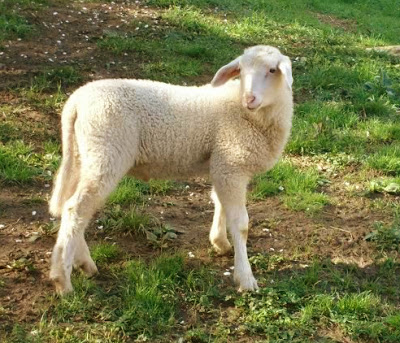East Friesian Sheep
Category: Sheep

Facts about East Friesian Sheep, "Scientific name for East Friesian Sheep is Ovis aries". East Friesian milk sheep is also called Friesian milk sheep which is from Germany and East Friesland. The East Friesian Sheep are also found on Zealand Island, West Friesland etc. The East Friesian Sheep have originated from Friesland as well as the East Friesland areas that are available on the north of Germany and Holland.
The East Friesian Sheep have large frames and which is a good characteristic for providing lean meat. Both East Friesian Sheep rams and ewes are polled in this type of breed. The East Friesian Sheep do not have wool on their legs, ears, and face. The ears of this sheep are forward pointing and the wool and face are white. The feet of the East Friesian Sheep are pale or white in color. The tail of the breed is usually called as rat tail as it is long, without wool and very thin. The noses of this breed are pink in color.
The matured East Friesian Sheep of this breed can weigh in between 150 to 200 pounds (68 to 90.7 kg). The udders of the ewes are wide and separated from each other and also have teats that are directed downwards. The wool available from the East Friesian Sheep breed is significantly long and it can be available in the length of 4 23/32 to 6 5/16 inches (11.9 to 16 cm). It can be ideal for using in carpet making. The weight of the fleece collected can be something that ranges from 8.8 to 11 pounds (4 to 5 kg). The ewes of the East Friesian Sheep breed are very fertile and in single birth they usually produce triplets. The East Friesian Sheep can breed without considering the season. The East Friesian Sheep average size of a litter can be considered as 2.25 lambs. There are more chances for triplets in the case of the East Friesian Sheep breed.
The milk production of the East Friesian Sheep breed is also much significant and they can produce about 80 to 160 gallons (300 to 600 liters) of milk in a day. This is the breed that produces the hugest volume of milk compared to another diary sheep. They have also the capacity for producing maximum of 238 gallons (900 liters) of milk in occasional cases. The fat in the milk can come around 6 to 7 percentage and it can have total solids of about 18 percentage within the milk. The East Friesian Sheep can be found in small numbers in various parts of the country and is mainly used as milk producer in households. In recent times an increasing market for specialty cheeses has resulted into a significant development in the number of East Friesian Sheep ewes being milked commercially.
Some East Friesian Sheep Facts
A East Friesian Sheep has a life expectancy between 6 1/2 to 11 years. Milk from sheep has a higher level of zinc, calcium, protein, fat, riboflavin, thiamine and niacin than milk from cows or a goat. A "flock or herd" is a group of East Friesian Sheep. "Lamb" is the name of a young East Friesian Sheep and it is called a sheep or "hogget" at one year old. "Ewe" is the name of the female East Friesian Sheep. "Ram" is the name of the adult male East Friesian Sheep. "Wether" is an adult castrated male sheep. The act of breeding for sheep is called "tubing". East Friesian Sheep give birth to 1 to 3 baby lambs once or twice a year. "lambing" is the act of giving birth for sheep.
A lamb weighs on average when born, about 5 to 8 pounds (2.2 to 3.6 kg). Sheep are born without or with horns (polled). The high pitched sound a baby lamb makes is called "bleating". The length of a pregnancy (gestation period) for a East Friesian Sheep is about 145 to 156 days.
Milk from Sheep is mostly used to make gourmet cheese. A East Friesian Sheep has an average body temperature of about 102.5ËšF (39.1Ëš Cel).
A lambs is usually sold on average for meat between 90 to 120 pounds (41 to 54.4 kg). "Mutton" is the name of the meat from a full grown sheep. There is a split in the East Friesian Sheep upper lip which allows them to select their favorite leaves off a plant.
A East Friesian Sheep is a herbivores, that eats leaves, grass, hay and furns. A sheep has four chambers to its digestive system that helps break down what they eat. East Friesian Sheep are "Ruminant" is any hoofed even-toed, mammal that digests its food in two stages. First by eating the raw materials and regurgitating a semi-digested form known as "cud" (ruminating:
chewing the cud.) then eating the cud.
In the world there are over 1 billion sheep and China has the most sheep in the world.
East Friesian Sheep have a 300 degrees field of vision and sheep do not have to turn their head to see behind them and they have excellent hearing. Sheep have long been used to control unwanted vegetation. Shelter is not necessary in the rain but East Friesian Sheep do seek shade from the sun. There are over 900 different sheep breeds in the world and 40 different breeds of sheep in the United States. A East Friesian Sheep does not have teeth in their upper front jaw. East Friesian Sheep have 32 teeth. East Friesian Sheep have 24 molars and 8 incisors in their mouth. A sheep has only lower teeth that press against an upper palette.

 Back To Category Sheep
Back To Category Sheep